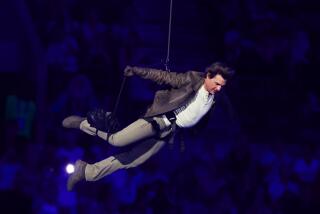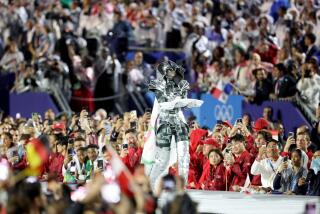Diavolo Frames Movement in the Context of Metaphor
In Olympic competition, an athlete maneuvers on a balance beam. In a concert by Jacques Heim’s Diavolo Dance Theater, a woman executes similar balances atop a door frame. The difference: movement becomes metaphor.
And that was the constant in a three-part program, “La Serie des Te^tes” over the weekend at Schoenberg Hall, UCLA.
In “Te^te au Carre,” dancers maneuvered on a huge open-frame cage, defying gravity and behaving as if they were pure geometric principles or forces. At times the cage seemed to disappear and a dancer hung in the air magically.
But the introduction of others creates human conflicts and solutions in how to share and dominate confined space.
A series of doors in “Te^te a Claque” becomes physical, social and psychological hurdles and opportunities, ranging from the sexual (Rebecca Butala and Nick Erickson’s “Bonjour” Duet) to the mystical (Mark Branner’s “Candle” solo).
A giant staircase in “Te^te en L’Air” provided the location for nonstop commuter activity, some of it purposeful, some nearly demented, some extraneous.
Heim (whose company is based in Los Angeles) and his collaborative dancers’ inspiration is not consistently high. When their imagination fails, the results are structurally inorganic. Debts and connections to Alwin Nikolais, Pilobolus and others, even Cirque du Soleil and Tap Dogs, are more or less evident.
Megan Godfrey’s solo atop the door frame in “Te^te a Claque” was presented at Cal State L.A. in November, but the larger whole work was receiving its premiere, although it was billed as “still in development.” “Te^te au Carre,” from 1993, was completely reconstructed. “Te^te en L’Air” has been seen locally since it was created in 1995. However, a spokesperson said, Heim always envisioned the three works as a trilogy, and they had never been presented together before Saturday.
Jean-Pierre Bedoyan composed and performed the percussive scores. Roger Webb designed the impressive sets. Jerry Browning created the dramatic lighting; Laura Brody, the costumes.
Prefacing each part was a whimsical vignette, including a chance for audience members to toss balls through a basketball hoop attached to Branner’s head.
More to Read
The biggest entertainment stories
Get our big stories about Hollywood, film, television, music, arts, culture and more right in your inbox as soon as they publish.
You may occasionally receive promotional content from the Los Angeles Times.










